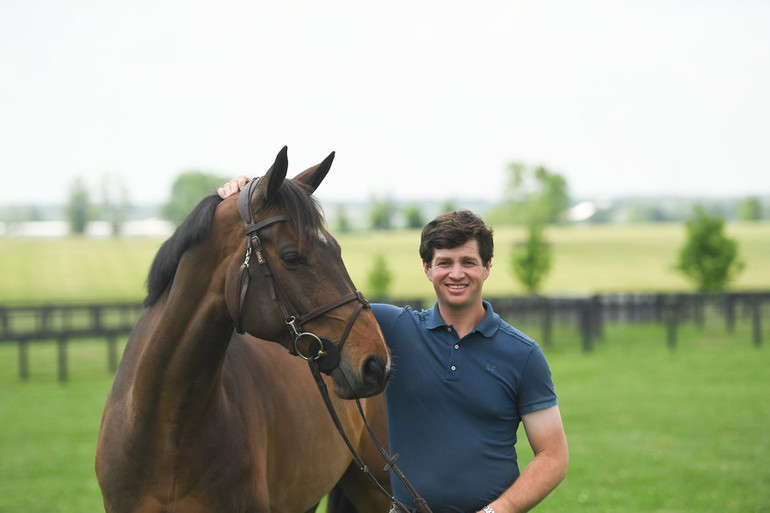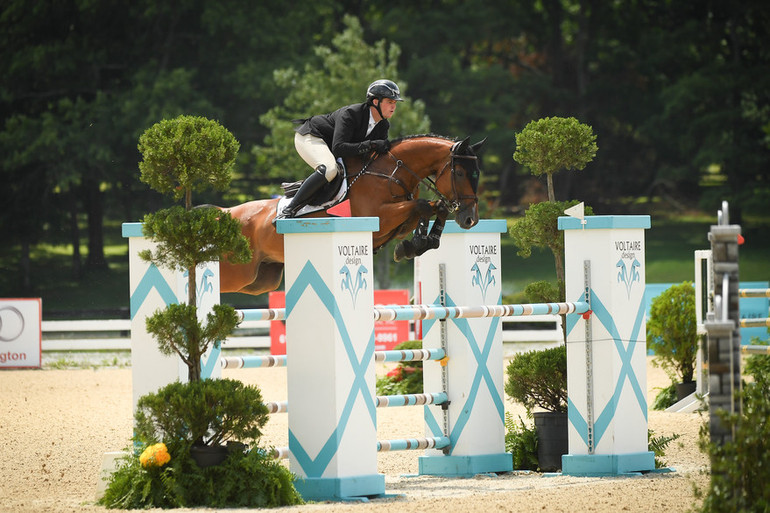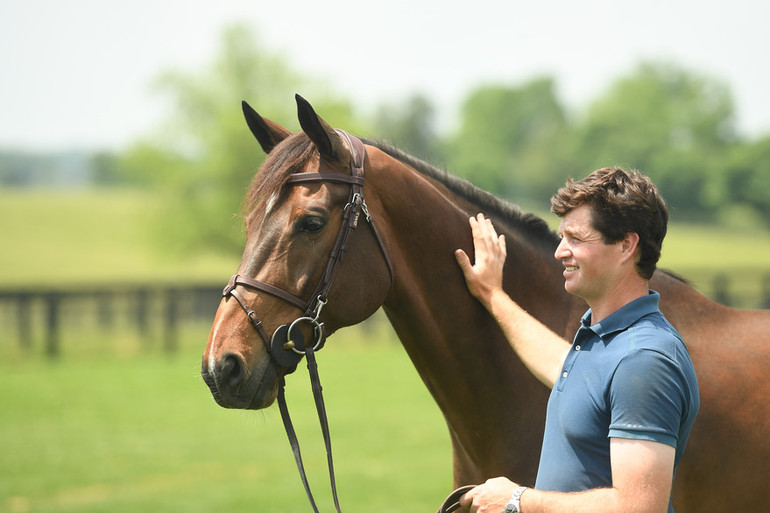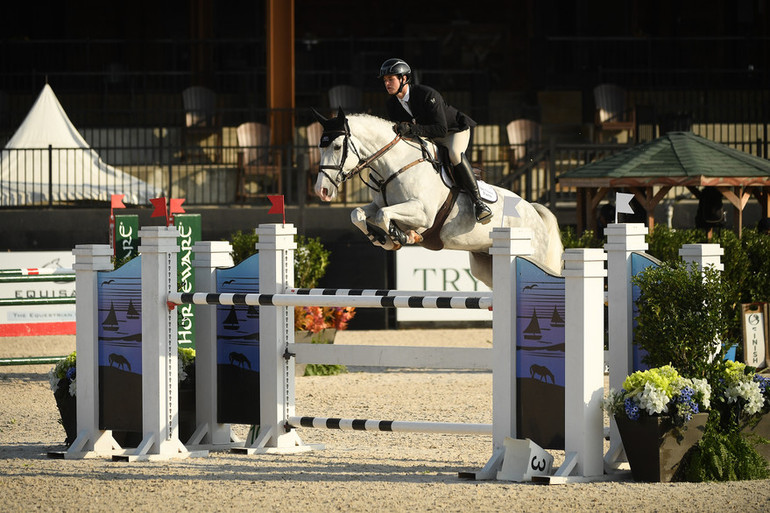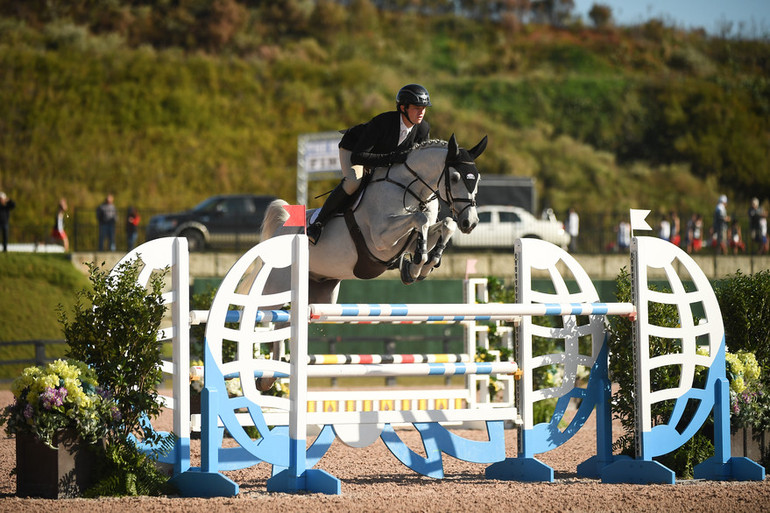Text © World of Showjumping
A winner of the US national young horse championships on multiple occasions, 33-year-old Irish rider David O’Brien has around 90 horses under his care at Spy Coast Farm in Lexington, Kentucky. In his role as the head trainer of the Spy Coast young horse development centre, O’Brien is responsible for overseeing the young horses from they are two until they are ready for the international rings.
Spy Coast Farm in Lexington, Kentucky has a breeding and a rehab section, two full-time vets, a full-time farrier and close to 300 horses onsite. “Next to the young horses, we have six stallions on the farm, our own mares and carrier mares which we rent,” O’Brien explains about the huge operation. “In addition to our own stallions, we also use frozen semen and have our own ICSI station where we can collect oocytes from the mares. We have about 35 foals per year, half of them from clients.”
“We are lucky enough to be right next to the Kentucky Horse Park, so during the summer we can bring the horses over and ride on the cross-country track and canter them around,” O’Brien continues. “This way, we get the young horses as much exposure as we can. For me, the most important thing with young horses is to take your time and valuate each horse as they are. Some horses need more, some less – you must recognize what is required for each horse. You have to treat each horse as they need to be treated.”
O’Brien has a team of people helping him get the youngsters started. “We try to keep everything very simple,” he tells about their working philosophy. “First of all, we have to be patient with the horses. The first thing they have to learn is the mounting block: For a lot of the clients over here that is needed. We train the horses to be patient and relaxed, and they are trained in a sense of being kind – we use a lot of treats.”
“In the fall when the horses are 2 years old, we evaluate them: Mostly the colts, since we want to see which ones we want to keep as stallions and which ones should be gelded. The ones that we keep as stallions, we start towards the end when they are two. I take over the riding when the horses are around four,” O’Brien continues. “I produce them and bring them to shows. How long I get to ride them depends on each horse; this year I have two 9-year-olds and from that age group Spy Coast Farm started with 27 foals.”
“We start the young horses on the tack, we work with them a little bit and then put them back in the field,” O’Brien explains about the routine they follow with the youngsters. “The fillies we start around February when they are three and some of them might get bred as well. When we start the horses, we do simple things: We start them in a round pen, work them first with a bridle, then with a saddle. We longline them around the yard before we get on them. From there on, we stage it out: We get them up to a point where they are jumping crossed rails and small courses, then give them a break. Come January when they are four, we get them back in from the field and get them ready for a small show in April.”
“I have a lot of freedom to set my program and my goals for the year, which I like,” O’Brien continues. “I get to really pick out which horses are aimed at which events, which will be sold, and which should breed. In America, there are currently no FEI young horse classes, only the national finals. At the moment I have a good group of young horses, so I want to aim again at the young horse finals. Last year we were quite successful in Tryon; I won the finals in all age groups.”
After eight years at Spy Coast Farm, O’Brien has learned what to look for in a good young horse. “When I first have them on the tack, what I like to feel is a lot of power,” he explains. “When you get on a young one to start they might throw a few bucks and jump around a bit. However, I believe it to be a good thing: When they have that power, they test you. The good ones will show their ability. Their reaction over the first pole on the ground is a good indication.”
“Since we breed a lot and each horse has a different job, we have to do very varied work with them,” O’Brien says. “Some horses might end up being trail horses, so they have to learn to trail ride around the base, others might need to learn how to jump cross country jumps.”
Originally from Galway in West Ireland, O’Brien grew up at the equestrian centre his parents run. “We have a Dublin qualifier and other shows at our yard, so I have been around horses my whole life,” he tells about his background. At home in Galway, David’s parents also do some breeding: Chloe Reid’s former top horse Codarco (Darco x Orame) was bred by David’s father Tomas, and produced by David and his brother Thomas. “Over the last couple of years, the breeding at my parents’ yard in Ireland has steadily grown,” O’Brien tells. “My father still has Codarco’s mother. I showed Codarco when he was four, and we won the national championship in Dublin, Ireland. I also won the 4-year-old final at Millstreet with him and when I left to work in America, my brother showed Codarco as a 5-year-old. In 2012, they came 5th at the World Breeding Championship in Lanaken, Belgium.”
“I learned a lot from my father, he showed me everything,” O’Brien continues. “My father lives every day for showjumping and producing horses – if I get half of his drive and passion, I will be happy. I will try to push myself as far as I can: I want to be able to do as much as my father has.”
“Long-term, I want to get more horses to compete on a higher level, and to jump Grand Prix classes,” O’Brien tells about his goals. “Last year, I was lucky to get a horse from Shane Sweetnam, an 8-year-old that needed time and exposure on bigger jumps. I came second in the Grand Prix in Kentucky with him and we got to do some FEI classes before he went back to Shane. Shane has a longstanding partnership with Lisa Laurie and Spy Coast: He is an advisor for the breeding operation and when he has a horse that needs more time and experience, I might get to campaign them. For example, I got to ride Kirschwasser Scf (Amaretto D’arco x Nabab de Reve), that Shane jumped on four- and five-star level before he was sold to Freddie Vasquez.”
“I believe that jumping on the higher level is what everyone is aiming for,” O’Brien says. “At the moment, I have a horse I brought up the ranks and he has won a few national Grand Prix classes. To get horses to the high level and to maybe keep a few of them, is always a goal. I want to get up there and campaign more internationally.”
No reproduction without written permission, copyright © World of Showjumping, photos © Katherine Hay



